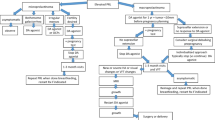Abstract
Hyperprolactinemia in premenopausal women often presents with amenorrhea, symptoms of estrogen deficiency and sub-fertility. After exclusion of other common causes and in the context of a normal pituitary MRI scan, hyperprolactinemia is typically deemed “idiopathic.” Here we present a case where excess prolactin secretion was attributed to a uterine fibroid and following myomectomy the hyperprolactinemia and its clinical sequelae resolved. Following 6 years of secondary infertility, a 41-year-old woman presented with secondary amenorrhea, expressible galactorrhea, and symptoms of estrogen deficiency. Prolactin levels were consistently raised (1300 mU/L to 2100 mU/L, reference interval < 600 mU/L), and repeated pituitary imaging demonstrated no pituitary abnormality. Prolactin levels demonstrated a paradoxical rise in response to dopamine agonist therapy (2000 mU/L to 5900 mU/L). Imaging demonstrated a uterine fibroid and the patient underwent myomectomy. Following myomectomy, prolactin levels became undetectable, galactorrhea and symptoms of estrogen deficiency resolved, menses returned, and a planned unassisted pregnancy followed. Ectopic prolactin secretion from uterine fibroids is a rare cause of hyperprolactinemia and can result in the same clinical sequelae as pituitary causes. As ectopic prolactin secretion is not under inhibitory control of dopamine, it is usually resistant to, or may rise in response to, dopamine agonist therapy. Prior to a diagnosis of “idiopathic” hyperprolactinemia, ectopic sources of prolactin should be considered.

Similar content being viewed by others
References
Horseman N, Gregerson K. Prolactin. In: Jameson J, De Groot L, editors. Endocrinology: adult and pediatric. 7th Edition: Saunders; 2017. p. 91–103.
Sethi BK, Chanukya GV, Nagesh VS. Prolactin and cancer: has the orphan finally found a home? Indian J Endocrinol Metab. 2012;16:S195–8.
Marano RJ, Ben-Jonathan N. Minireview: extrapituitary prolactin: an update on the distribution, regulation, and functions. Mol Endocrinol. 2014;28:622–33.
Korytnaya E, Liu J, Camelo-Piragua S, Sullivan S, Auchus RJ, Barkan A. Ectopic prolactin secretion from a perivascular epithelioid cell tumor (PEComa). J Clin Endocrinol Metab. 2014;99:3960–4.
Proust-Lemoine E, Mitchell V, Deruelle P, Lamblin A, Néraud B, Leroy X, et al. Ectopic hyperprolactinaemia in a woman with a mesocolic perivascular epithelioid cell tumor (“PEComa”). Ann Endocrinol (Paris). 2008;69(240–243).
Gururaj S, Nisal K, Davies Q, Deen S, McNally PG. Ectopic prolactin secretion secondary to an ovarian tumour. Endocrinol Diabetes Metab Case Rep. 2013:130016.
Hoffman WH, Gala RR, Kovacs K, Subramanian MG. Ectopic prolactin secretion from a gonadoblastoma. Cancer. 1987;60:2690–5.
Elms AF, Carlan SJ, Rich AE, Cerezo L. Ovarian tumor-derived ectopic hyperprolactinemia. Pituitary. 2012;15:552–5.
Nambiar KR, Nair SG, Devi RN. Acute myeloid leukemia presenting as galactorrhea. Proc (Bayl Univ Med Cent). 2016;29(395).
Hatfill SJ, Kirby R, Hanley M, Rybicki E, Böhm L. Hyperprolactinemia in acute myeloid leukemia and indication of ectopic expression of human prolactin in blast cells of a patient of subtype M4. Leuk Res. 1990;14:57–62.
See WS, Cheuk DK, Fung KL, Chan GC. Acute lymphoblastic leukaemia presenting with galactorrhoea. BMJ Case Rep. 2013. https://doi.org/10.1136/bcr-2012-007461.
Soroush AR, Zadeh HM, Moemeni M, Shakiba B, Elmi S. Plasma prolactin in patients with colorectal cancer. BMC Cancer. 2004;4:97.
Bhatavdekar JM, Patel DD, Chikhlikar PR, Shah NG, Vora HH, Ghosh N, et al. Ectopic production of prolactin by colorectal adenocarcinoma. Dis Colon Rectum. 2001;44:119–27.
Arbaiza D, Noriega K, Marcial J, Wachtel A, Perez C, Torres CF. Ectopic production of prolactin in an infant with non-Hodgkin lymphoma. Med Pediatr Oncol. 1999;32:311–2.
Stanisic TH, Donovan J. Prolactin secreting renal cell carcinoma. J Urol. 1986;136:85–6.
Quek ML, Soni RA, Hsu J, Skinner DG. Renal epithelioid angiomyolipoma associated with hyperprolactinemia. Urology. 2005;65:797.
Hsu CT, Yu MH, Lee CY, Jong HL, Yeh MY. Ectopic production of prolactin in uterine cervical carcinoma. Gynecol Oncol. 1992;44:166–71.
Turkington RW. Ectopic production of prolactin. N Engl J Med. 1971;285(26):1455–8.
Herzog AG. Migraine with ectopic hyperprolactinemia from uterine fibroids. Neurology. 2000;55:148–9.
Cordiano V. Complete remission of hyperprolactinemia and erythrocytosis after hysterectomy for a uterine fibroid in a woman with a previous diagnosis of prolactin-secreting pituitary microadenoma. Ann Hematol. 2005;84:200–2.
Simsir IY, Kocabas GU, Sahin SB, Erdogan M, Cetinkalp S, Saygili F, et al. A case of an ectopic prolactinoma. Gynecol Endocrinol. 2012;28:148–9.
Sato H, Asami Y, Shiro R, Yasuda M, Imai S, Sakai R, et al. Resolution of dopamine agonist-resistant hyperprolactinemia by hysterectomy: a case report. Gynecol Endocrinol. 2018;34:199–201.
Power RF, Mani SK, Codina J, Conneely OM, O’Malley BW. Dopaminergic and ligand-independent activation of steroid hormone receptors. Science. 1991;254:1636–9.
Hiraoka Y, Tatsumi K, Shiozawa M, Aiso S, Fukasawa T, Yasuda K, et al. A placenta-specific 5′ non-coding exon of human prolactin. Mol Cell Endocrinol. 1991;75:71–80.
Gellersen B, Kempf R, Telgmann R, DiMattia GE. Nonpituitary human prolactin gene transcription is independent of Pit-1 and differentially controlled in lymphocytes and in endometrial stroma. Mol Endocrinol. 1994;8:356–73.
Author information
Authors and Affiliations
Corresponding author
Ethics declarations
Conflict of Interest
The authors declare that they have no conflict of interest.
Ethical Approval
All procedures performed were in accordance with the ethical standards of the National Health Advisory Committee’s Ethical Guidelines for Observational Studies and with the 1964 Helsinki declaration and its later amendments or comparable ethical standards.
Statement of Informed Consent
Written informed consent was given by the patient for investigation and publication.
Additional information
Publisher’s Note
Springer Nature remains neutral with regard to jurisdictional claims in published maps and institutional affiliations.
This article is part of the Topical Collection on Medicine
Rights and permissions
About this article
Cite this article
Upreti, R., Dray, M. & Elston, M.S. Uterine Fibroid Causing Hyperprolactinemia and Paradoxical Prolactin Rise with Dopamine Agonist: Case Report and Systematic Review. SN Compr. Clin. Med. 2, 464–467 (2020). https://doi.org/10.1007/s42399-020-00248-6
Accepted:
Published:
Issue Date:
DOI: https://doi.org/10.1007/s42399-020-00248-6



